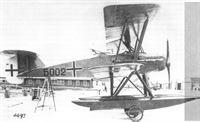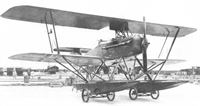
Описание
Страна: Германия
Год: 1918
O.Thetford, P.Gray German Aircraft of the First World War (Putnam)
Albatros W 8
Marine Nos. 5001-5003 were allocated to W 8 type, but only the first two aircraft are believed to have been supplied, during 1918. Intended for fighting patrol duties and as a possible successor to the Brandenburg W 12, the W 8 incorporated some of the features of the Heinkel-designed machine, notably the high-set tailplane. However, as this was now set atop the vertical fin, it was particularly vulnerable and had not the strength factor of the Brandenburg, with its upswept fuselage to carry the tailplane. The other Albatros W 8 differed only in being fitted with a pointed spinner. Engine, 195 h.p. Benz IIIb vee eight. Span, 11.46 m. (37 ft. 1 1/4 in.). Length, 9.59 m. (31 ft. 5 5/8 in.). Height, 3.39 m. (11 ft. 1 1/2 in.). Speed, 150 km.hr. (93.75 m.p.h.). Climb, 1,000 m. (3,280 ft.) in 6.5 min., 3,000 m. (9,840 ft.) in 34 min. Useful load, 500 kg. (1,100 lb.). Duration, 3.5 hr. Armament, one fixed Spandau machine-gun forward, one manually operated Parabellum machine-gun in rear cockpit.
Описание:
- O.Thetford, P.Gray German Aircraft of the First World War (Putnam)
- J.Herris German Seaplane Fighters of WWI (A Centennial Perspective on Great War Airplanes 2)
- J.Herris Albatros Aircraft of WWI. Vol.3: Bombers, Seaplanes, J-types (A Centennial Perspective on Great War Airplanes 26)
Фотографии
-
J.Herris - German Seaplane Fighters of WWI /Centennial Perspective/ (2)
The first prototype Albatros W8 was a handsome, well-streamlined two-seat fighter powered by a V-8 that was not yet in mass production. However, the flat radiator under the wing somewhat spoiled the overall streamlining.
-
J.Herris - Albatros Aircraft of WWI. Volume 3: Bombers, Seaplanes, J-types /Centennial Perspective/ (26)
View of Marine #5002, the second Albatros W8 prototype, shows that the elegant spinner of the prototype was abandoned. Otherwise #5502 appears to incorporate no other visible changes. The block radiator beneath the upper wing undoubtedly produced a lot of drag, and one wonders if it was intended for use in production aircraft if any had been ordered. A nose radiator seems better suited to minimize cooling drag. (Peter M. Bowers Collection/Museum of Flight)
-
J.Herris - Albatros Aircraft of WWI. Volume 3: Bombers, Seaplanes, J-types /Centennial Perspective/ (26)
View of Marine #5002, the second Albatros W8 prototype, shows that the elegant spinner of the prototype was abandoned. Otherwise #5502 appears to incorporate no other visible changes.
-
J.Herris - Albatros Aircraft of WWI. Volume 3: Bombers, Seaplanes, J-types /Centennial Perspective/ (26)
Additional view of Marine Number 5002, the second Albatros W.8 prototype. Despite elimination of the elegant spinner of the first prototype, the W.8 had clean lines and small frontal area marred only by the bulky block radiator beneath the upper wing. (Peter M. Bowers Collection/Museum of Flight)





